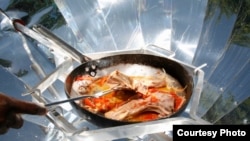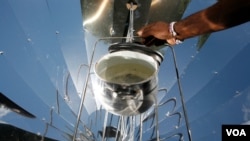This is Part Four of a five-part series on Renewable Energy for Africa
Continue to Parts: 1 / 2 / 3 / 4 / 5
Eleven years ago, Crosby Menzies walked away from his marketing job for The Wall Street Journal’s London office. “Financially, I was doing fine but my heart just wasn’t in my work,” he recalled.
Sparking his sudden decision, Menzies said, was a passion for sustainable development. “I’ve always been interested in protecting the environment and helping people live better lives. I felt I couldn’t do this by sitting behind a computer all day, every day.”
Menzies left England and returned to the country of his birth, South Africa. There, he studied permaculture – a form of agriculture that allows people to establish sustainable organic gardens and farms – with a view to helping schools in impoverished areas of Africa to grow their own food.
But a visit to Zambia sent Menzies’ life spinning yet again in a completely different direction.
He recalled, “I saw some women cooking food on some very rudimentary solar cookers. A light went on in my head and I thought to myself, instead of teaching people to grow healthy food, maybe I can teach them to cook healthy food.…”
Menzies added, “A solar cooker seemed to me to be the solution to a problem that millions of poor Africans have, and that is their daily struggle to cook their food, given that most of them don’t have electricity.”
But, in trying to fulfill his vision, he faced a problem of his own: He didn’t know anything about solar energy technology.
Parabolic dishes
Menzies, however, wasn’t about to let his lack of knowledge stifle his will to succeed. He read all he could about solar cookers that were already being manufactured around the world. He traveled the globe, learning about the latest international solar energy technologies. For almost a decade he experimented with various designs, until he came up with his own model.
“It uses a parabolic [curved] dish that looks like a satellite dish. In fact it works on the same principal as a satellite dish receiving signals from space,” he said.
But, instead of distributing signals from outer space to a television set, his foil-coated aluminum dishes distribute heat from the sun to a center point on the dish, over which food can be cooked – in much the same way as a magnifying glass can be used to concentrate heat from the sun on a piece of paper, eventually causing it to burst into flame.
“It’s exactly like moving fire from the sun and putting it onto your pot,” Menzies said.
His parabolic dish cookers are mounted on tripods for stability that also permit the cooker to be moved 360 degrees, allowing users to track the sun.
“With the parabolic dish, you need to change its angle or position every 20 minutes or so to ensure maximum performance. This is because the sun moves every 20 minutes by a considerable degree,” said Menzies. “Every 20 minutes or 30 minutes… you just come along and you see where your focal point is, where the sun is, and you just move it under your pot or frying pan, just to make sure you’re concentrating all of that sunlight onto the pot.”
He said using the cooker is very similar to using a conventional electric or gas stove, and they’re particularly well suited to almost immediate boiling and frying. “They get hot pretty fast. You could for instance start cooking on the parabolic cooker in the morning and do the tea, coffee and eggs for your children before you send them to school,” he said.
Slow cooking
Armed with a design he was convinced was “top class,” the entrepreneur decided to establish a business.
“When I told people I wanted to start a solar cooker company, I think they all sort of knew that my plan would fail,” Menzies laughed. “I was told right at the beginning that running a solar cooker company and making it feasible and financially stable was impossible. That was in fact my inspiration for starting the company.”
Aptly, he called his firm SunFire. Eight years later, Menzies’ products are available in 40 countries in Africa. His company is the leading distributor of solar cookers on the continent.
The firm has also designed solar ovens and plans to begin production soon. These are suitable for slower forms of cooking, such as stewing and roasting. They’re box-shaped, have a wooden frame and a material casing. “They work on the principle of a greenhouse for plants,” Menzies explained.
Reflective foil on the top of the box channels sunlight into the chamber, heating it and turning it into a “slow cooking” oven, he said. “What’s great about our ovens is that they allow unattended cooking, unlike our parabolic cookers, which have to be attended all the time because of the high temperatures they reach.”
Menzies said users often place his solar ovens in the sun in the morning and leave home to run errands. “You would actually prepare your lunch in the morning and put it in the solar oven. Come lunchtime, you come back and your lunch is already cooked. They do not get to a temperature that can burn your food, so there’s no danger that you’re going to come back and it’s totally crisp.”
As the SunFire solar ovens work at very low temperatures, they won’t cause fire if left unattended, said Menzies, and food stays warm for a long time without becoming dry and unappetizing.
Solar cooking benefits
SunFire also provides training to communities that use its solar cookers.
“Whole streets get together and cook together for a week under our supervision and they soon get the hang of solar cooking. Then once you’re done with that you’re able to make a difference from day one. From the minute that the cookers are installed, families are starting to save money and time,” said Menzies.
He’s convinced that cooking by means of the sun also saves lives and protects the environment.
“Every year thousands of Africans lose their lives in fires caused by cheap and unstable paraffin stoves being knocked over. Many people also die from respiratory diseases caused by indoor air pollution from smoke from fires and inhaling paraffin fumes. None of this happens with solar cookers,” said Menzies.
He said solar cooking also eliminates the need to cut down trees for firewood and reduces carbon emissions from coal and wood burning.
“Everything that’s cooked with a solar cooker essentially means that some sort of a fossil fuel, or carbon-based fuel, is not being burnt,” said Menzies.
Seeing and eating are believing
Despite the success of his cookers and ovens, Menzies acknowledged that he always has a hard time convincing people that they work.
“It doesn’t seem to matter if it is the president of South Africa or a herd boy in Lesotho, it’s astonishing – the response is the same. And we’ve done demonstrations in Germany; we’ve done demonstrations all over the world, and people are very incredulous that food can actually be cooked with the sun,” he said.
Menzies added that he’d shown his products to environmentalists and scientists all over the world.
“Even they struggle to believe that a chicken is being cooked with only sunlight,” he said, laughing. “The usual response from people when they see food being cooked with our solar cookers is that they start looking for the electric cable attached to our cooker. I’ve also had people who think it’s a magic show, an illusion.”
But, as Menzies emphasized, “Seeing – and eating – is believing! And when people see our cookers working and they taste the food, then they believe that heat from the sun can cook food….”
He insisted that food cooked by means of solar heating is much healthier than meals prepared using electricity and gas. “Your food is delicious, very succulent. There’s a definite change in the way that food tastes when it’s cooked with sunlight…. It just tastes better. Every single person that we’ve ever put out a solar cooker [to] has come back to us and said, ‘Wow, the food is just absolutely amazing.’”
Cost factor
But, at a cost of more than $140 for a basic solar cooker, Africa’s poor cannot afford SunFire’s products.
“The major challenge facing us as we try to get our products to as many Africans as possible is on the finance side of things. The people who generally see the value in the solar cookers are quite often the poorest of the poor,” said Menzies.
To solve this problem, he founded an NGO called Solar Cookers for Africa. “We’ll soon be ready to start reaching poor communities and providing them with cookers through donations,” he said.
Menzies is convinced that in the near future solar cookers will become ubiquitous in Africa. He draws his inspiration from the pervasiveness of cellphones all over the continent. Just a few years ago, he said, not many would have predicted the phenomenon.
“But go to the biggest and poorest slums of Africa. The people living there don’t have electricity or a decent house or clothes or cars. But they have sometimes a better cellphone than you do and they’re taking pictures of you as you come to visit their village!” Menzies said.
To some, his ambition may sound impossible to fulfill. But, given all he has so far achieved, with no formal education in designing quality solar cooking technologies, Menzies maintained that his objective is not at all far-fetched.
He said, “Every day, just to survive, people across Africa achieve much more than I do with far fewer resources. They inspire me.”
Continue to Parts: 1 / 2 / 3 / 4 / 5
Eleven years ago, Crosby Menzies walked away from his marketing job for The Wall Street Journal’s London office. “Financially, I was doing fine but my heart just wasn’t in my work,” he recalled.
Sparking his sudden decision, Menzies said, was a passion for sustainable development. “I’ve always been interested in protecting the environment and helping people live better lives. I felt I couldn’t do this by sitting behind a computer all day, every day.”
Menzies left England and returned to the country of his birth, South Africa. There, he studied permaculture – a form of agriculture that allows people to establish sustainable organic gardens and farms – with a view to helping schools in impoverished areas of Africa to grow their own food.
But a visit to Zambia sent Menzies’ life spinning yet again in a completely different direction.
He recalled, “I saw some women cooking food on some very rudimentary solar cookers. A light went on in my head and I thought to myself, instead of teaching people to grow healthy food, maybe I can teach them to cook healthy food.…”
Menzies added, “A solar cooker seemed to me to be the solution to a problem that millions of poor Africans have, and that is their daily struggle to cook their food, given that most of them don’t have electricity.”
But, in trying to fulfill his vision, he faced a problem of his own: He didn’t know anything about solar energy technology.
Parabolic dishes
Menzies, however, wasn’t about to let his lack of knowledge stifle his will to succeed. He read all he could about solar cookers that were already being manufactured around the world. He traveled the globe, learning about the latest international solar energy technologies. For almost a decade he experimented with various designs, until he came up with his own model.
“It uses a parabolic [curved] dish that looks like a satellite dish. In fact it works on the same principal as a satellite dish receiving signals from space,” he said.
But, instead of distributing signals from outer space to a television set, his foil-coated aluminum dishes distribute heat from the sun to a center point on the dish, over which food can be cooked – in much the same way as a magnifying glass can be used to concentrate heat from the sun on a piece of paper, eventually causing it to burst into flame.
“It’s exactly like moving fire from the sun and putting it onto your pot,” Menzies said.
His parabolic dish cookers are mounted on tripods for stability that also permit the cooker to be moved 360 degrees, allowing users to track the sun.
“With the parabolic dish, you need to change its angle or position every 20 minutes or so to ensure maximum performance. This is because the sun moves every 20 minutes by a considerable degree,” said Menzies. “Every 20 minutes or 30 minutes… you just come along and you see where your focal point is, where the sun is, and you just move it under your pot or frying pan, just to make sure you’re concentrating all of that sunlight onto the pot.”
He said using the cooker is very similar to using a conventional electric or gas stove, and they’re particularly well suited to almost immediate boiling and frying. “They get hot pretty fast. You could for instance start cooking on the parabolic cooker in the morning and do the tea, coffee and eggs for your children before you send them to school,” he said.
Slow cooking
Armed with a design he was convinced was “top class,” the entrepreneur decided to establish a business.
“When I told people I wanted to start a solar cooker company, I think they all sort of knew that my plan would fail,” Menzies laughed. “I was told right at the beginning that running a solar cooker company and making it feasible and financially stable was impossible. That was in fact my inspiration for starting the company.”
Aptly, he called his firm SunFire. Eight years later, Menzies’ products are available in 40 countries in Africa. His company is the leading distributor of solar cookers on the continent.
The firm has also designed solar ovens and plans to begin production soon. These are suitable for slower forms of cooking, such as stewing and roasting. They’re box-shaped, have a wooden frame and a material casing. “They work on the principle of a greenhouse for plants,” Menzies explained.
Reflective foil on the top of the box channels sunlight into the chamber, heating it and turning it into a “slow cooking” oven, he said. “What’s great about our ovens is that they allow unattended cooking, unlike our parabolic cookers, which have to be attended all the time because of the high temperatures they reach.”
Menzies said users often place his solar ovens in the sun in the morning and leave home to run errands. “You would actually prepare your lunch in the morning and put it in the solar oven. Come lunchtime, you come back and your lunch is already cooked. They do not get to a temperature that can burn your food, so there’s no danger that you’re going to come back and it’s totally crisp.”
As the SunFire solar ovens work at very low temperatures, they won’t cause fire if left unattended, said Menzies, and food stays warm for a long time without becoming dry and unappetizing.
Solar cooking benefits
SunFire also provides training to communities that use its solar cookers.
“Whole streets get together and cook together for a week under our supervision and they soon get the hang of solar cooking. Then once you’re done with that you’re able to make a difference from day one. From the minute that the cookers are installed, families are starting to save money and time,” said Menzies.
He’s convinced that cooking by means of the sun also saves lives and protects the environment.
“Every year thousands of Africans lose their lives in fires caused by cheap and unstable paraffin stoves being knocked over. Many people also die from respiratory diseases caused by indoor air pollution from smoke from fires and inhaling paraffin fumes. None of this happens with solar cookers,” said Menzies.
He said solar cooking also eliminates the need to cut down trees for firewood and reduces carbon emissions from coal and wood burning.
“Everything that’s cooked with a solar cooker essentially means that some sort of a fossil fuel, or carbon-based fuel, is not being burnt,” said Menzies.
Seeing and eating are believing
Despite the success of his cookers and ovens, Menzies acknowledged that he always has a hard time convincing people that they work.
“It doesn’t seem to matter if it is the president of South Africa or a herd boy in Lesotho, it’s astonishing – the response is the same. And we’ve done demonstrations in Germany; we’ve done demonstrations all over the world, and people are very incredulous that food can actually be cooked with the sun,” he said.
Menzies added that he’d shown his products to environmentalists and scientists all over the world.
“Even they struggle to believe that a chicken is being cooked with only sunlight,” he said, laughing. “The usual response from people when they see food being cooked with our solar cookers is that they start looking for the electric cable attached to our cooker. I’ve also had people who think it’s a magic show, an illusion.”
But, as Menzies emphasized, “Seeing – and eating – is believing! And when people see our cookers working and they taste the food, then they believe that heat from the sun can cook food….”
He insisted that food cooked by means of solar heating is much healthier than meals prepared using electricity and gas. “Your food is delicious, very succulent. There’s a definite change in the way that food tastes when it’s cooked with sunlight…. It just tastes better. Every single person that we’ve ever put out a solar cooker [to] has come back to us and said, ‘Wow, the food is just absolutely amazing.’”
Cost factor
But, at a cost of more than $140 for a basic solar cooker, Africa’s poor cannot afford SunFire’s products.
“The major challenge facing us as we try to get our products to as many Africans as possible is on the finance side of things. The people who generally see the value in the solar cookers are quite often the poorest of the poor,” said Menzies.
To solve this problem, he founded an NGO called Solar Cookers for Africa. “We’ll soon be ready to start reaching poor communities and providing them with cookers through donations,” he said.
Menzies is convinced that in the near future solar cookers will become ubiquitous in Africa. He draws his inspiration from the pervasiveness of cellphones all over the continent. Just a few years ago, he said, not many would have predicted the phenomenon.
“But go to the biggest and poorest slums of Africa. The people living there don’t have electricity or a decent house or clothes or cars. But they have sometimes a better cellphone than you do and they’re taking pictures of you as you come to visit their village!” Menzies said.
To some, his ambition may sound impossible to fulfill. But, given all he has so far achieved, with no formal education in designing quality solar cooking technologies, Menzies maintained that his objective is not at all far-fetched.
He said, “Every day, just to survive, people across Africa achieve much more than I do with far fewer resources. They inspire me.”




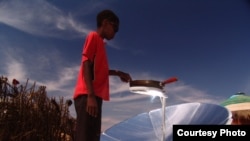
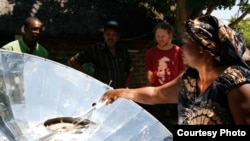
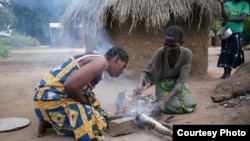

![Menzies [far left] shows one of his solar cookers to villagers in Zambia (Photo: Sunfire)](https://gdb.voanews.com/2AE71221-9240-4864-9ADC-66310E372BE2_w250_r1_s.jpg)
